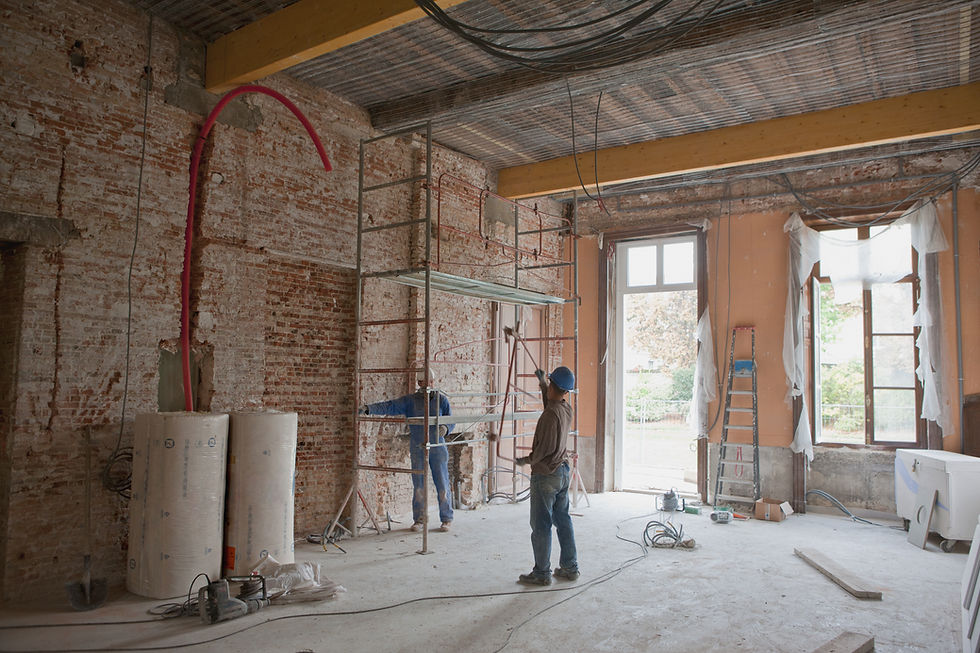Renovating Without Adding Value: Why More Isn’t Always More
- strmweb
- Aug 6
- 3 min read
Updated: 4 days ago
It’s easy to get swept up in the excitement of transforming your home. A bigger kitchen, a loft conversion, a new layout, all in the name of better living. But here’s the catch: not all renovation work increases your home’s value. In fact, many homeowners invest tens of thousands into upgrades that never generate a return, and in some cases, even reduce their property’s appeal to future buyers.
So how do you avoid overcapitalising? And which improvements actually make financial sense?

The Renovation Trap: When Spending Doesn’t Pay Off
Recent research by the Office for National Statistics shows that UK households spent over £30 billion on home improvements last year. Yet according to estate agents, nearly 1 in 5 major renovation projects fail to add any real value to the home.
Even more concerning, around 10 percent of sellers report that extensive refurbishments have actually made their property harder to sell, often due to overly personal design choices, poor space planning, or investing more than the ceiling price of the local market.
The issue isn’t with renovating itself. The problem is renovating without strategy.
Why It Happens
Here are the most common ways homeowners miss the mark:
Over-personalisation
Highly specific styles or layouts may suit your lifestyle but alienate future buyers.
Ignoring the local market
Adding high-end finishes in a mid-range neighbourhood can price your property out of the area.
Poor planning
Rearranging layouts or extending without improving flow, storage, or daylight often results in costly changes with little reward.
Neglecting balance
Creating one showstopping space (like a huge kitchen) but leaving the rest of the house underwhelming or impractical can deter buyers.
Renovations That Actually Add Value
While every home is different, some alterations are consistently recognised by property professionals as offering the best return on investment:
1. Loft Conversions
Can add up to 15–20% to property value (Nationwide Building Society)
Especially valuable when they include an extra bedroom and en-suite
2. Rear Extensions (modest, well-designed)
Can add 10–15% depending on size and finish
Open-plan layouts with lots of natural light and a connection to the garden are most desirable
3. Kitchen Improvements
Full remodels aren’t always necessary
A well-planned kitchen upgrade can add 5–10%, especially when layout and storage are improved
4. Energy Efficiency Upgrades
EPC improvements are becoming increasingly important for buyers
Homes with better energy ratings are selling faster and often at higher values
Consider insulation, air source heat pumps, and triple glazing
5. Updating Bathrooms
New fixtures, better lighting, and clever storage can add impact
Small but well-designed bathrooms consistently attract buyer attention
6. Enhancing Kerb Appeal
First impressions matter
Improving front landscaping, repainting, and updating the entrance can boost perceived value by up to 5%
What to Avoid
Luxury finishes that don’t match the rest of the property
Removing bedrooms to create oversized spaces
Adding structures that eat into outdoor space without improving internal flow
Extensive basement conversions in areas where they’re not in demand
Investing beyond the ceiling price of your road or postcode

How to Renovate with Strategy
At the core of every valuable renovation is balance; between design and practicality, cost and return, personal taste and market expectations.
Here’s what we advise:
Start with a feasibility review of your home’s potential and local market
Prioritise flow, natural light, and flexibility over square footage alone
Design with longevity in mind: good bones, timeless layout, and future adaptability
Work with professionals who understand both design and value
In Summary
Renovating your home is about more than just aesthetics. If you’re investing significant time and money, it’s worth thinking carefully about the impact of every decision; not just how it feels now, but how it might shape your home’s value in years to come. Thoughtful design adds more than beauty. It adds clarity, comfort, and long-term return.




